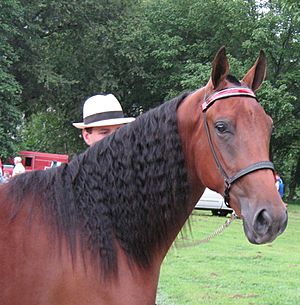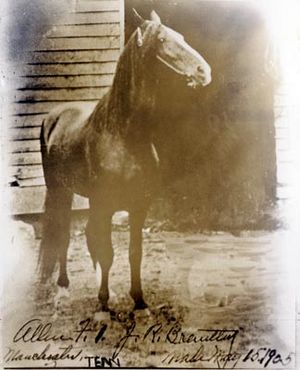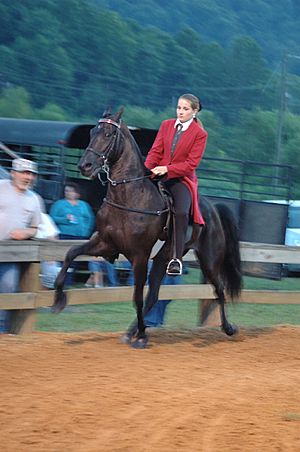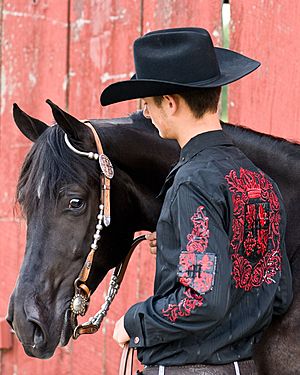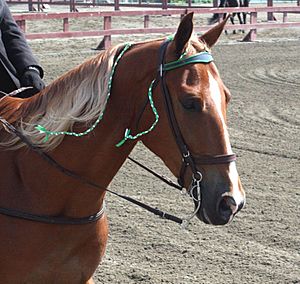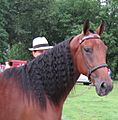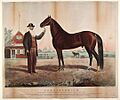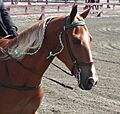Tennessee Walking Horse facts for kids
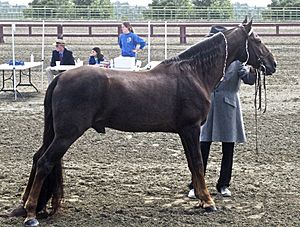
Flat-shod Tennessee Walking Horse
|
|
| Distinguishing features | Unique running-walk, tall, long neck; calm disposition; long, straight head |
|---|---|
| Alternative names | Tennessee Walker Walking Horse Walker TWH |
| Country of origin | Tennessee, USA |
| Breed standards | |
| Tennessee Walking Horse Breeders' and Exhibitors' Association | Breed standards |
| National Walking Horse Association | Breed standards |
| Horse (Equus ferus caballus) | |
The Tennessee Walking Horse is a special type of horse. It is famous for its unique four-beat "running-walk" gait. This horse was first bred in the southern United States. People used them on farms and large plantations.
These horses are popular for riding. They have a calm personality and a very smooth ride. You often see Tennessee Walking Horses in horse shows. They are also great for pleasure riding and trail riding. People use them with both English and Western saddles. You might even spot them in movies and TV shows!
The breed started in the late 1700s. Narragansett Pacers and Canadian Pacers were bred with gaited Spanish Mustangs. Other breeds were added later. In 1886, a foal named Black Allan was born. He is known as the main father of the breed. The Tennessee Walking Horse Breeders' Association was formed in 1935. They closed their official list of horses in 1947. The first Tennessee Walking Horse National Celebration was held in 1939.
In recent years, this yearly event has faced some challenges. There have been efforts to stop people from hurting horses. This abuse was done to make horses perform better in shows.
There are two main types of Tennessee Walking Horse show competitions. They are called "flat-shod" and "performance." Flat-shod horses wear regular horseshoes. They show less exaggerated movements. Performance horses wear special thick pads on their hooves. They also use other weighted devices. This creates a very high-stepping style called the "Big Lick." Some horse groups now ban these pads and devices in their shows.
The Tennessee Walking Horse breed is most affected by the Horse Protection Act of 1970. This law stops a harmful practice called soring. Soring is when people abuse horses' legs to make them do the "Big Lick" movement. Even with the law, some horses are still hurt. This problem has caused disagreements within the breed community. It has also led to new groups being formed.
Contents
What Makes Them Special?
The Tennessee Walking Horse is known for being elegant and strong. It is a tall horse with a long neck. Its head is well-shaped, with small, well-placed ears. These horses are usually between 14.3 and 17 hands tall. They weigh about 900 to 1200 pounds. Their shoulders and hips are long and sloped. They have a short back and strong muscles. Their hind legs can be slightly angled, which is normal for the breed.
They come in many different colors. You can find common colors like bay, black, and chestnut. They also come in colors like dun, champagne, cream, and silver dapple. Some have pinto patterns like overo, sabino, and tobiano.
Tennessee Walking Horses are known for their calm nature. They also have a naturally smooth riding gait. Even though they are famous for flashy show movements, they are also popular for trail and pleasure riding.
Their Unique Gaits
The Tennessee Walking Horse is best known for its running-walk. This is a four-beat gait. It has the same foot pattern as a normal walk, but it is much faster. A regular walk is about 4 to 8 miles per hour. The running-walk can be 10 to 20 miles per hour! In the running-walk, the horse's back feet step past its front feet. This "overstep" can be 6 to 18 inches. A longer overstep is highly valued in the breed. When doing the running-walk, the horse nods its head in time with its steps.
Besides the flat walk and running walk, the third main gait is the canter. Some Tennessee Walking Horses can do other smooth gaits. These include the rack, stepping pace, fox trot, and single-foot. These are fine for pleasure riding. However, they are not preferred in the show ring. A few Tennessee Walking Horses can also trot. They have a long, reaching stride.
History of the Breed

The Tennessee Walker started when Narragansett Pacer and Canadian Pacer horses were brought to Tennessee. This began around 1790. These horses were bred with gaited Spanish Mustangs from Texas. These new horses were raised in the rich limestone areas of Middle Tennessee. They became known as "Tennessee Pacers."
They were used as all-around horses on plantations and farms. People rode them, used them for pulling, and even for racing. They were famous for their smooth gaits and sure footing on rocky land. Over time, Morgan, Standardbred, Thoroughbred, and American Saddlebred blood was added.
In 1886, Black Allan was born. His father was Allendorf, a Standardbred. His mother was Maggie Marshall, a Morgan mare. Black Allan became the main father of the Tennessee Walking Horse breed. He was not good at trotting because he preferred to pace. So, he was used for breeding instead. From his line, a foal named Roan Allen was born in 1904. Roan Allen could do several smooth gaits. He became a successful show horse and had many famous Tennessee Walking Horse offspring.
The Tennessee Walking Horse Breeders' Association was formed in 1935. In 1974, its name changed to the Tennessee Walking Horse Breeders' and Exhibitors' Association (TWHBEA). The official list of horses, called the stud book, was closed in 1947. This means that since then, both parents of a Tennessee Walker must be registered for the foal to be registered. In 1950, the United States Department of Agriculture officially recognized the breed.
In 2000, the Tennessee Walking Horse became the official state horse of Tennessee. It is also the third most common breed in Kentucky. As of 2005, over 450,000 horses have been registered with the TWHBEA. About 13,000 to 15,000 new foals are registered each year. While most Tennessee Walking Horses are in the southern US, they are found all over the country.
How They Are Used
The Tennessee Walker is well-known for horse show events. They often perform in saddle seat-style English riding shows. But they are also very popular for trail riding. Some are even used for endurance riding. To encourage this, the TWHBEA has an awards program with the American Endurance Ride Conference.
In the 1900s, Tennessee Walking Horses were bred with Welsh ponies. This created a new gaited pony breed called the American Walking Pony.
This breed has also appeared in TV shows, movies, and other performances. For example, the Lone Ranger's horse "Silver" was sometimes played by a Tennessee Walker. "Trigger, Jr.," who followed the famous "Trigger" of Roy Rogers, was a Tennessee Walker named Allen's Gold Zephyr. The mascot for the University of Southern California Trojans, named Traveler, was sometimes a purebred Tennessee Walking Horse. It was also sometimes a Tennessee Walker mixed with an Arabian.
Horse Shows
There are two main types of Tennessee Walking Horse competitions: "flat-shod" and "performance." Flat-shod horses compete in many different styles. They use both Western and English saddles. In shows that offer both, the flat-shod "plantation pleasure" division judges horses on their beauty and presence. They must also be well-behaved, balanced, and easy to manage. "Park pleasure" is the most lively of the flat-shod divisions. Flat-shod horses wear regular horseshoes. They are not allowed to use pads or special action devices. Their hooves are sometimes trimmed at a slightly lower angle.
Tennessee Walking Horses usually have long manes and tails for shows. Tails that are artificially set high are seen in "performance" classes. They are also seen in classes for adult horses judged on their looks, and in some driving classes. However, they are generally not allowed in pleasure or flat-shod competitions.
Performance horses are sometimes called "padded" or "built up." They show very flashy and lively gaits. They lift their front legs high with each step. This exaggerated movement is sometimes called the "Big Lick." Riders usually wear saddle seat style clothing and use matching tack. These horses wear special thick pads on their hooves, sometimes called "stacks." In the early 2000s, this type of shoeing was banned by some groups like the National Walking Horse Association (NWHA) and the United States Equestrian Federation (USEF).
Horses in Western classes wear equipment similar to other breeds in western pleasure classes. Riders cannot mix English and Western-style equipment. Riders must wear a hat or helmet in Western classes. Tennessee Walkers are also shown in both pleasure and fine harness driving classes. Their grooming is similar to saddle seat horses. In classes where horses use saddle seat equipment, they typically wear a single curb bit. Riders wear typical saddle seat clothing. Hats are not always required, but safety helmets are allowed. They are strongly encouraged or even required in some pleasure classes.
Show Rules and Groups
There have been disagreements about shoeing rules and concerns about soring. This has led to many different groups governing the breed. The official breed registry is kept by the TWHBEA. This group supports all riding styles for the breed, but it does not approve horse shows itself.
The USEF does not currently recognize any Tennessee Walking Horse shows. In 2013, it banned the use of action devices and stacks in all classes.
The Tennessee Walking Horse Heritage Society works to protect the original bloodlines of the breed. They focus on horses for trail and pleasure riding, not just showing. Horses listed by this group come from the original horses registered by the TWHBEA. Their family trees cannot include horses that were shown with stacks after 1976.
Two groups have formed to promote shows for flat-shod horses. The National Walking Horse Association (NWHA) only supports naturally gaited horses in its shows. It has its own rule book and is linked with the USEF for the breed. The NWHA approves horse shows and licenses judges.
Friends of Sound Horses (FOSH) also supports shows for flat-shod and barefoot horses. It licenses judges for pleasure classes and gaited dressage. It also promotes using gaited horses in distance riding and sport horse activities.
Two groups make rules for horse shows where action devices are allowed. These are the Walking Horse Owners Association (WHOA) and "S.H.O.W." ("Sound horses, Honest judging, Objective inspections, Winning fairly"). This group regulates the Tennessee Walking Horse National Celebration. The Celebration has been held in Shelbyville, Tennessee, every August since 1939. It is considered the most important competition for the breed. In recent years, the Celebration has received a lot of attention. This is due to concerns about violations of the Horse Protection Act.
Images for kids
-
Hambletonian 10, the foundation stallion of the family that produced Black Allan
See also
 In Spanish: Caballo Tennessee Walking para niños
In Spanish: Caballo Tennessee Walking para niños


